Finches are a diverse group of small to medium-sized birds with conical bills and colorful plumage. They inhabit a wide range of habitats and have distinctive flight calls.
There are over 230 species of true finches, which include redpolls, grosbeaks, crossbills, and siskins. In North America, there are 17 finch species, including crossbills, grosbeaks, redpolls, and siskins.
You are reading: 12 Types Of Finch Birds With Pictures
In this article, we will explore 12 types of finch birds with pictures. We will learn about their habitats, appearance, diets, and nests. Additionally, we will provide links to more pictures of finches and a comprehensive overview of the finch family.

12 Types Of Finch Birds With Pictures
Cassin’s Finch
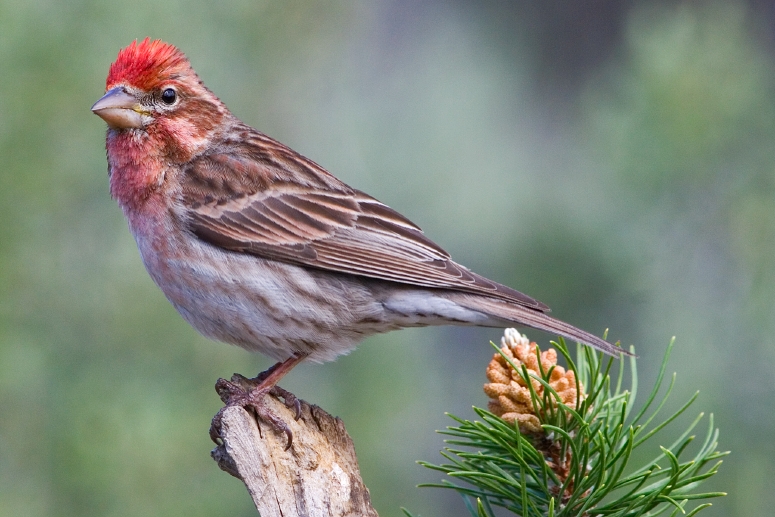
Cassin’s Finch (Haemorhous cassinii) is a small songbird in the finch family, Fringillidae. Here are some key characteristics of Cassin’s Finch:
Appearance:
– Length: 6.3 in (16 cm)
– Weight: 0.8-1.2 oz (24-34 g)
– Wingspan: 9.8-10.6 in (25-27 cm)
– Peaked head
– Short-medium tail
– Heavy bill that is fairly long and straight-sided
– Rosy-tinged plumage
Habitat:
– Mountains and conifer forests of the western United States
– Breeds in the mountains of the western United States and Mexico
– Winters in the southwestern United States and Mexico
Diet:
– Feeds on seeds, insects, and berries
Nesting:
– Builds a cup-shaped nest in a conifer tree
– Lays 3-5 eggs
Cassin’s Finch is slightly less well-known than its lookalikes, the House Finch and Purple Finch. Females are similar to Purple Finch but with a more diffuse face pattern and finer streaks on flanks. Both sexes tend to show a more peaked head and longer bill than the House Finch.
House Finch

The House Finch (Haemorhous mexicanus) is a small songbird in the finch family, Fringillidae. Here are some key characteristics of the House Finch:
Appearance:
– Length: 5.1-5.5 in (13-14 cm)
– Weight: 0.6-0.9 oz (16-27 g)
– Wingspan: 7.9-9.8 in (20-25 cm)
– Small-bodied finch with a relatively large beak and somewhat long, flat head
– Short wings, making the tail seem long by comparison
– Shallow notch in its tail
– Males have red head, breast, and rump, but not on their brown back or belly
– Females have plain brown plumage with heavy streaking on the underparts
Habitat:
– Cities, suburbs, farms, canyons, and open woods
– Original habitat was probably streamside trees and brush in dry country, woodland edges, chaparral, and other semi-open areas
– Now most commonly associated with humans in cities, towns, and farmland, especially in areas with lawns, weedy areas, trees, and buildings
– Avoids unbroken forest or grassland
Diet:
– Feeds on seeds, fruits, and insects
– Often visits bird feeders
Nesting:
– Builds a cup-shaped nest in a tree or shrub
– Lays 3-6 eggs
House Finches are adaptable, colorful, and cheery-voiced birds that are common from coast to coast in North America. They are familiar visitors to backyard feeders and are now abundant over much of North America.
However, local populations in some areas have been hard hit by a bacterial infection called conjunctivitis, which swells their eyes shut and makes it difficult for them to feed themselves.
Purple Finch
The Purple Finch (Haemorhous purpureus) is a medium-sized bird in the finch family, Fringillidae. Here are some key characteristics of the Purple Finch:
Appearance:
– Length: 5.5-6.3 in (14-16 cm)
– Weight: 0.6-1.1 oz (17-31 g)
– Wingspan: 9.8-11.8 in (25-30 cm)
– Short, forked brown tail and brown wings
– Adult males are raspberry red on the head, breast, back, and rump, with a brownish back and white belly
– Adult females have light brown upperparts and white underparts with dark brown streaks throughout, with a white line on the face above the eye
Habitat:
– Breeds in the northern United States, southern Canada, and the west coast
– Prefers nesting in lowland coniferous and mixed forests, avoiding heavily populated urban areas, but sometimes found in rural residential areas
– Winters in a wider variety of habitats with trees
Diet:
– Feeds on seeds, buds, and insects
– Visits bird feeders
Nesting:
– Builds a cup-shaped nest on horizontal branches of coniferous trees, away from the trunk
– Lays 3-5 eggs
The Purple Finch is well-known for the males’ bright purplish-red plumage. They have a sweet warbling song and are often seen at bird feeders. The Purple Finch is common in the North and East, and along the Pacific seaboard, but it is very rare in much of the Rocky Mountains region.
Black Rosy-Finch
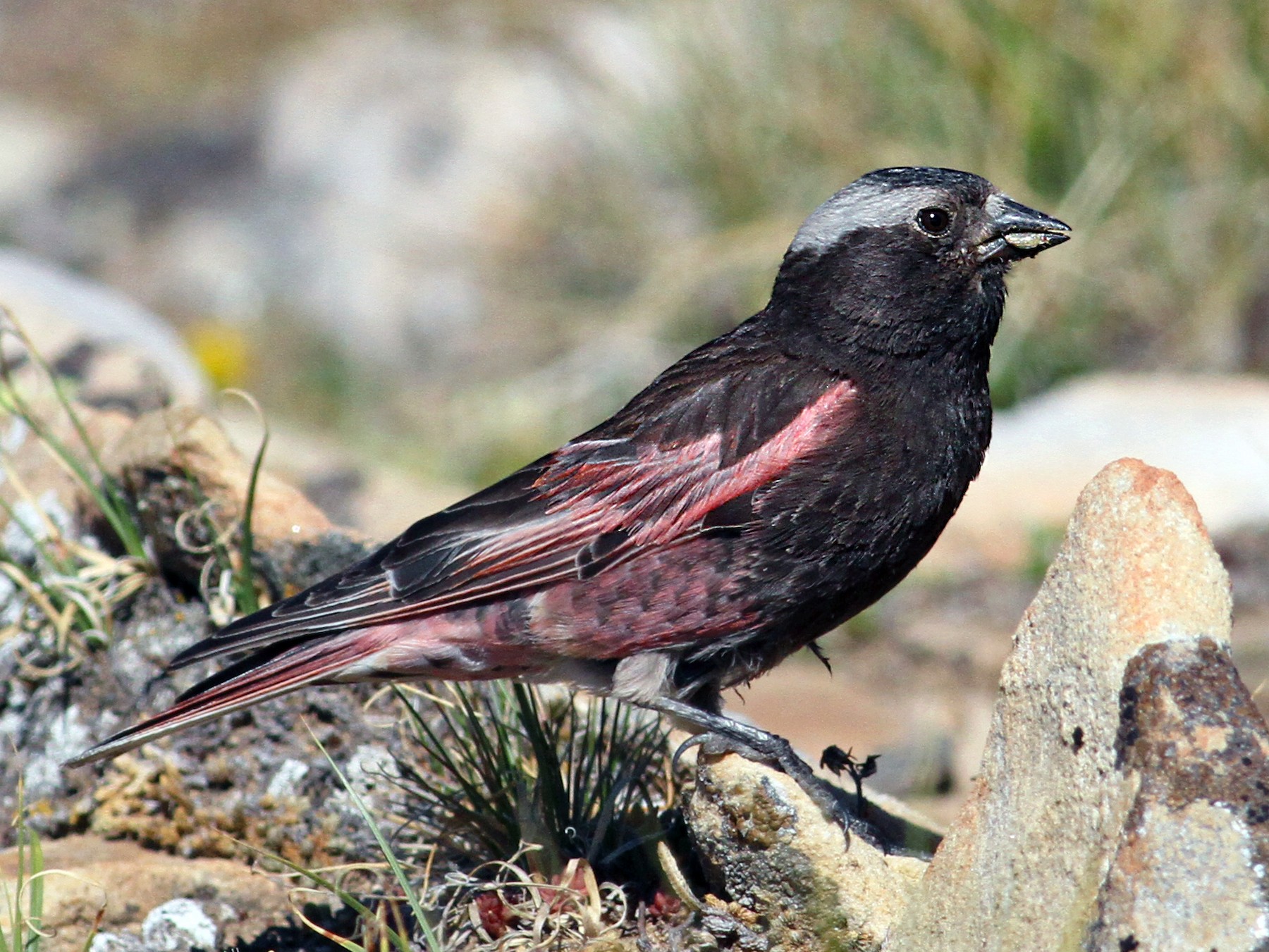
The Black Rosy-Finch (Leucosticte atrata) is a medium-sized passerine bird in the finch family, Fringillidae. Here are some key characteristics of the Black Rosy-Finch:
Appearance:
– Length: 5.5-6.3 in (14-16 cm)
– Weight: 0.8-1.1 oz (23-31 g)
– Wingspan: 10.2-11.0 in (26-28 cm)
– Medium-sized, chunky finch with a conical bill and a notched tail
– Breeding birds are blackish overall with pink highlights on the wings and belly
– Gray cap and gray wraps around the back of the head
– Non-breeding birds are brownish-gray overall with pink highlights on the wings and belly
Habitat:
– Alpine areas above treeline of the western United States
– Breeds in high-altitude rocky areas with sparse vegetation
– Winters at lower elevations in rocky areas with sparse vegetation
Diet:
– Feeds on seeds, insects, and berries
Nesting:
– Builds a cup-shaped nest on a rocky ledge or crevice
– Lays 3-5 eggs
The Black Rosy-Finch is the most range-restricted member of its genus and is a popular photography subject for birdwatchers.
It is the darkest of the three rosy-finches, with a dark chocolate body and pink highlights in the wings and tail. The Black Rosy-Finch is rather uncommon and local, and its conservation status is of least concern.
Brown-Capped Rosy-finch
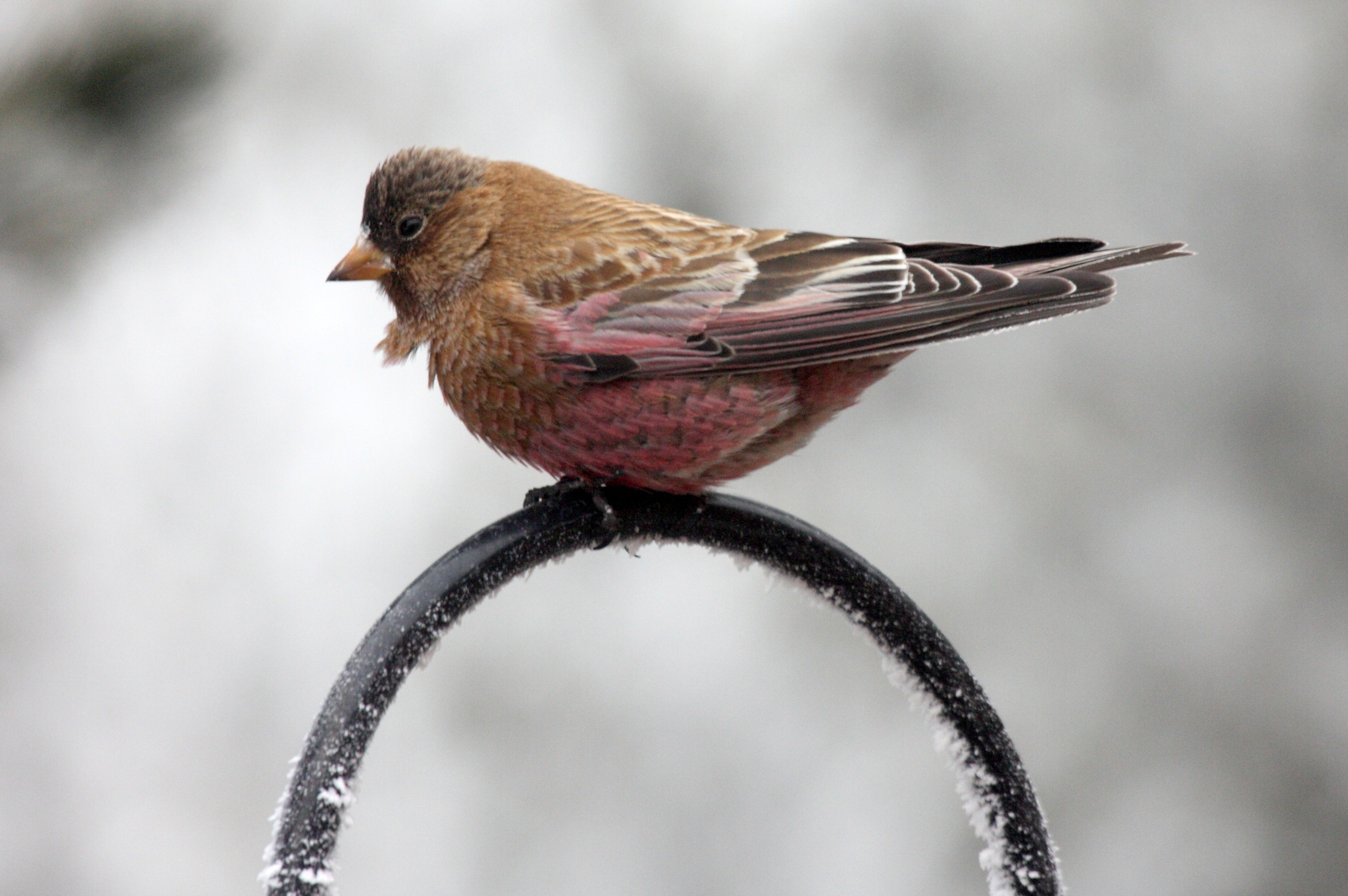
The Brown-Capped Rosy-Finch (Leucosticte australis) is a medium-sized finch that is endemic to North America. Here are some key characteristics of the Brown-Capped Rosy-Finch:
Appearance:
– Length: 5.5-6.3 in (14-16 cm)
– Weight: 0.8-1.1 oz (23-31 g)
– Wingspan: 10.2-11.0 in (26-28 cm)
– Milk-chocolate brown body
– Pink highlights in the wings, tail, belly, and indistinct grayish-brown crown
– Charcoal gray cap and tail
– Dark bill and legs
Habitat:
– Breeds almost entirely in Colorado, in high alpine areas near remote glaciers and snowy meadows
– Feeds on seeds and insects along the ground
– Descends to lower elevations in winter
Diet:
– Feeds on seeds and insects
Nesting:
– Builds a cup-shaped nest on a rocky ledge or crevice
– Lays 3-5 eggs
The Brown-Capped Rosy-Finch is the southernmost of three closely related species on this continent and has the smallest distribution, being almost endemic to Colorado. It is a high-altitude specialist that breeds in remote alpine areas near glaciers and snowy meadows.
The Brown-Capped Rosy-Finch is a rare bird that is difficult to observe, but it is a popular target for birdwatchers who are willing to make the effort to visit its remote habitat.
Gray-Crowned Rosy-Finch
The Gray-Crowned Rosy-Finch (Leucosticte tephrocotis) is a species of passerine bird in the family Fringillidae native to Alaska, western Canada, and the northwestern United States. Here are some key characteristics of the Gray-Crowned Rosy-Finch:
Appearance:
– Length: 5.5-6.3 in (14-16 cm)
– Weight: 0.8-1.1 oz (23-31 g)
– Wingspan: 10.2-11.0 in (26-28 cm)
– Dark brown overall with a gray crown and nape
– Pink highlights on the wings, tail, and belly
– Short, notched tail
Habitat:
– Breeds in remote and rocky alpine habitats, often near glaciers and snowfields
– Descends to lower elevations in winter
– Often found in mixed flocks with other rosy-finches
Diet:
– Feeds on seeds and insects
Nesting:
– Builds a cup-shaped nest on a rocky ledge or crevice
– Lays 3-5 eggs
The Gray-Crowned Rosy-Finch is one of four species of rosy finches and is among the hardiest of all birds, nesting in the highest parts of the highest mountains in North America.
Due to its remote and rocky alpine habitat, it is rarely seen. The Gray-Crowned Rosy-Finch is fairly widespread and not currently considered threatened.
American Goldfinch

The American Goldfinch (Spinus tristis) is a small passerine bird in the finch family, Fringillidae. Here are some key characteristics of the American Goldfinch:
Appearance:
– Length: 4.3-5.5 in (11-14 cm)
– Weight: 0.39-0.71 oz (11-20 g)
– Wingspan: 7.5-8.7 in (19-22 cm)
– Short, conical bill and small head
– Long wings and short, notched tail
– Males in breeding plumage are bright yellow with black wings and tail, while females and non-breeding males are duller yellow-green with brownish-gray wings and tail
– Both sexes have a small, conical bill that is pink for most of the year but turns bright orange during the breeding season
Habitat:
– Breeds across much of North America, from mid-Alberta to North Carolina
– Found in open and semi-open habitats, including fields, meadows, orchards, and residential areas
– Winters from just south of the Canada-United States border to Mexico
Diet:
– Feeds primarily on seeds, especially from thistle plants, and insects during the breeding season
– Common at bird feeders
Nesting:
– Builds a cup-shaped nest in a tree or shrub
– Lays 3-5 eggs
The American Goldfinch is a common and welcome visitor to bird feeders across much of North America. They are known for their bright yellow plumage during the breeding season and their distinctive flight call, which sounds like “potato-chip”.
The American Goldfinch is migratory, breeding in the northern United States and Canada and wintering in the southern United States and Mexico. They are evaluated as least concern on the IUCN Red List.
Lawrence’s Goldfinch

Lawrence’s Goldfinch (Spinus lawrencei) is a small songbird that breeds in California and Baja California and winters in the southwestern United States and northern Mexico. Here are some key characteristics of Lawrence’s Goldfinch:
Appearance:
– Length: 4.5-5.5 in (11-14 cm)
– Weight: 0.4-0.6 oz (11-17 g)
– Wingspan: 7.5-8.7 in (19-22 cm)
– Soft gray overall with a black face and throat
– Yellow breast and rump
– Complex black and yellow pattern on wings
– Females are duller and lack the black face and throat
Habitat:
– Found in oak-pine woodlands, chaparral, and other brushy habitats
– Breeds in California and Baja California
– Winters in the southwestern United States and northern Mexico
Diet:
– Feeds on seeds and insects
Nesting:
– Builds a cup-shaped nest in a tree or shrub
– Lays 3-5 eggs
Lawrence’s Goldfinch is unique among goldfinches because of its mostly gray body. Male Lawrence’s Goldfinches are among the most attractive of North American songbirds, with their soft gray overall set off by a black face and copious amounts of lemon-yellow on the wings and tail. They are uncommon and local, and could be vulnerable to loss of habitat.
Pine Grosbeak

The Pine Grosbeak (Pinicola enucleator) is a large member of the true finch family, Fringillidae. Here are some key characteristics of the Pine Grosbeak:
Appearance:
– Length: 8.7-10.2 in (22-26 cm)
– Weight: 1.8-2.5 oz (50-70 g)
– Wingspan: 12.2-13.4 in (31-34 cm)
– Males are pink overall with two white wingbars and pale gray highlights, while females and immature males are gray-brown with a yellowish wash on the head and rump
– Short, conical bill and long, slightly forked tail
Habitat:
– Found in coniferous woods across Alaska, the western mountains of the United States, Canada, and in subarctic Fennoscandia and across the Palearctic to Siberia
– Inhabits subarctic and boreal forests across Eurasia and North America, as well as montane conifer forests
– Often found in small flocks
Diet:
– Feeds mainly on seeds, buds, berries, and insects
– Favors small fruits, such as rowans (mountain-ashes in the New World)
Nesting:
– Builds a cup-shaped nest in a tree or shrub
– Lays 3-5 eggs
The Pine Grosbeak is a large, plump finch of the boreal forest that is uncommon but widespread in spruce and fir forests of the North and the high mountains. They are often absurdly tame, allowing very close approach.
Read more : The Top 8 Most Dangerous Birds In North America
Pine Grosbeaks are frugivores, especially in winter, favoring small fruits, such as rowans (mountain-ashes in the New World). They are evaluated as least concern on the IUCN Red List.
Evening Grosbeak
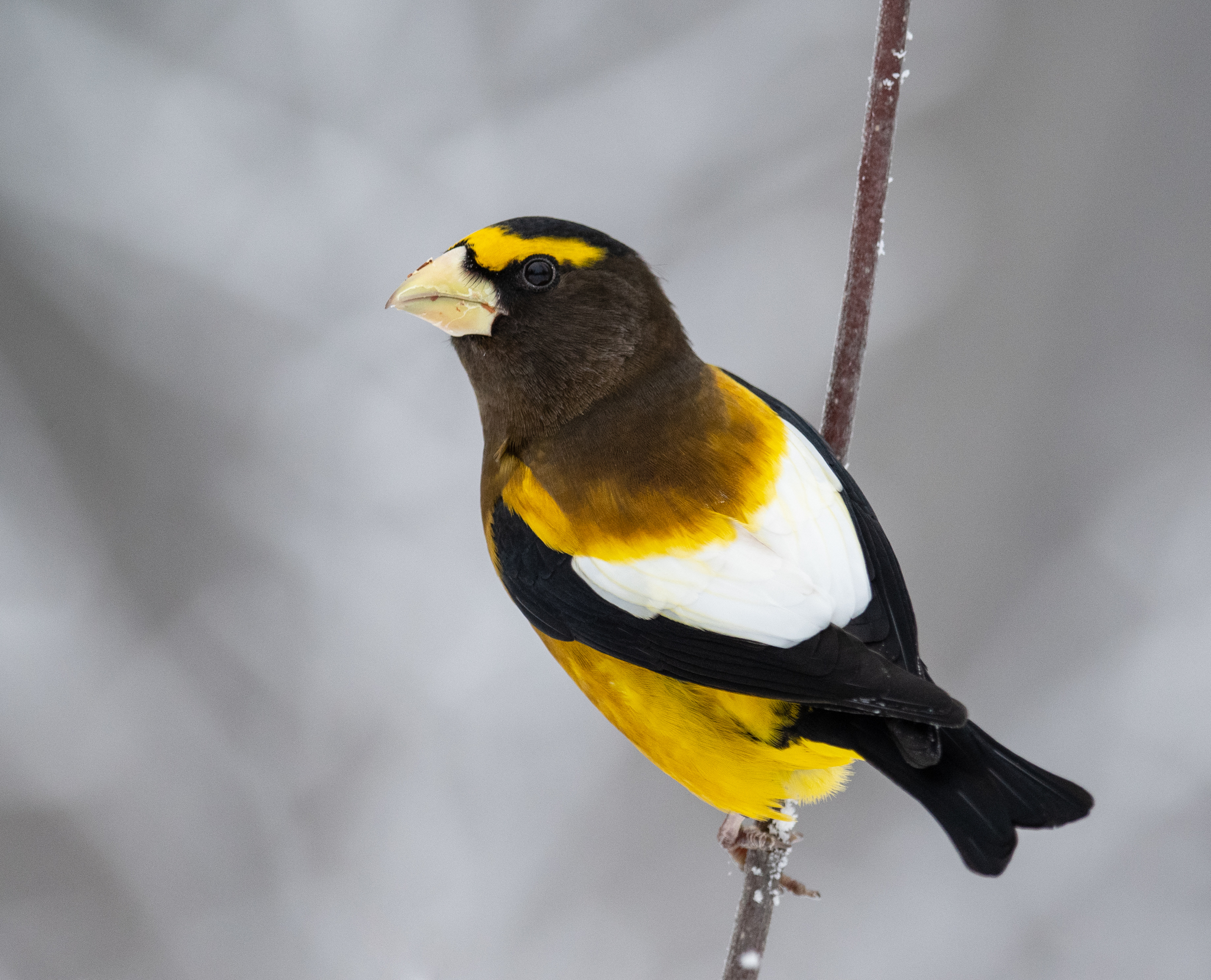
The Evening Grosbeak (Coccothraustes vespertinus) is a heavyset finch of northern coniferous forests. Here are some key characteristics of the Evening Grosbeak:
Appearance:
– Length: 6.7-8.3 in (17-21 cm)
– Weight: 1.5-2.0 oz (42-57 g)
– Wingspan: 11.8-13.4 in (30-34 cm)
– Males have a yellow forehead, black head, and bright yellow underparts, with black wings and tail and white wing patches
– Females are grayish-brown overall with yellow wing patches and a yellowish wash on the underparts
– Both sexes have a large, pale bill and short, notched tail
Habitat:
– Found in northern coniferous forests across North America
– Winters in the western and northeastern United States and southern Canada
– Often found in small flocks
Diet:
– Feeds mainly on seeds, especially those of box elder, ash, maple, and locust trees
– Also feeds on buds of deciduous trees, berries, small fruits, weed seeds, and insects
– Fond of sunflower seeds at bird feeders
Nesting:
– Builds a cup-shaped nest in a tree or shrub
– Lays 2-5 eggs
The Evening Grosbeak is a colorful and noisy bird that often descends on bird feeders in winter in colorful flocks. They are irruptive migrants, meaning that their movements are unpredictable and can vary greatly from year to year.
The Evening Grosbeak is declining dramatically, with a 92% decline since 1970, making it the steepest declining landbird in the continental United States.
Common Redpoll
The Common Redpoll (Acanthis flammea) is a small bird in the finch family, Fringillidae. Here are some key characteristics of the Common Redpoll:
Appearance:
– Length: 4.3-5.1 in (11-13 cm)
– Weight: 0.4-0.6 oz (11-18 g)
– Wingspan: 7.5-8.7 in (19-22 cm)
– Small, plump finch with a small, yellow bill and a notched tail
– Males have a pink breast, red forehead, and black bib, while females are duller with less red on the forehead and breast
Habitat:
– Found in northern forests across North America and Eurasia
– Breeds in the Arctic tundra and subarctic forests
– Winters in southern Canada and the northern United States
Diet:
– Feeds mainly on seeds, especially those of birch and alder trees
– Also feeds on buds, catkins, and insects
Nesting:
– Builds a cup-shaped nest in a tree or shrub
– Lays 4-6 eggs
The Common Redpoll is a small, plump finch that is fond of colder climates. They are active foragers that travel in busy flocks. The Common Redpoll is widespread and abundant, with a conservation status of least concern.
Pine Siskin
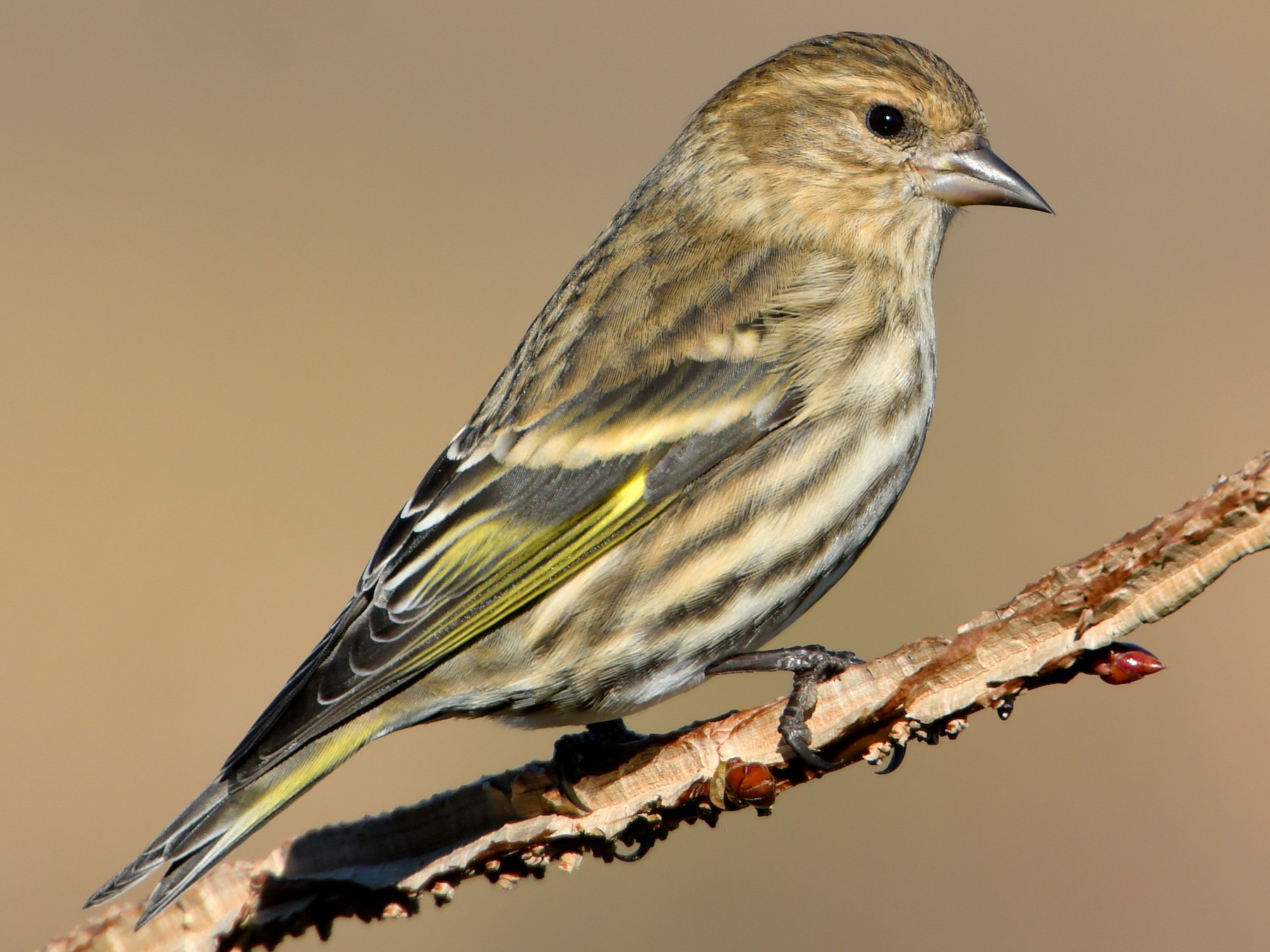
The Pine Siskin (Spinus pinus) is a small migratory bird in the finch family, Fringillidae. Here are some key characteristics of the Pine Siskin:
Appearance:
– Length: 4.3-5.1 in (11-13 cm)
– Weight: 0.4-0.6 oz (11-18 g)
– Wingspan: 7.5-8.7 in (19-22 cm)
– Small, plump finch with a short, notched tail and a slender, pointed bill
– Brownish-gray overall with heavy streaking on the breast and flanks
– Yellow wing bars and tail edges
Habitat:
– Found in coniferous and mixed forests across North America
– Breeds in Alaska and northern Canada and winters across the United States
Diet:
– Feeds mainly on seeds, especially those of coniferous trees, birch, and alder
– Also feeds on buds, catkins, and insects
– Often visits bird feeders
Nesting:
– Builds a cup-shaped nest in a tree or shrub
– Lays 3-5 eggs
The Pine Siskin is a nomadic bird that ranges widely and erratically across North America. They are often found in flocks and can be attracted to bird feeders with thistle or nyjer seed.
Pine Siskins are irruptive, meaning that their movements are unpredictable and can vary greatly from year to year. They are evaluated as least concern on the IUCN Red List.
FAQS
1. What are the 12 types of finch birds?
The 12 types of finch birds are Cassin’s Finch, House Finch, Purple Finch, Black Rosy-Finch, Brown-Capped Rosy-Finch, Gray-Crowned Rosy-Finch, American Goldfinch, Lawrence’s Goldfinch, Pine Grosbeak, Evening Grosbeak, Common Redpoll, and Pine Siskin.
2. Where can I find finch birds?
Finch birds can be found in a variety of habitats, including forests, woodlands, meadows, and residential areas. The specific habitat depends on the species of finch.
3. What do finch birds eat?
Finch birds primarily feed on seeds, but they also eat insects, fruits, and berries. Some species of finch are known to visit bird feeders.
4. How do I attract finch birds to my backyard?
To attract finch birds to your backyard, you can provide a variety of seeds, such as thistle or nyjer seed, in a bird feeder. You can also plant native trees and shrubs that produce seeds and berries that finch birds like to eat.
5. Are finch birds endangered?
Most species of finch birds are not endangered, but some species, such as the Brown-Capped Rosy-Finch, Black Rosy-Finch, and Cassia Crossbill, are considered to be at risk due to habitat loss and other threats.
6. What is the difference between male and female finch birds?
Male finch birds are often more brightly colored than females, with more vibrant plumage and distinctive markings. However, the specific differences between male and female finch birds depend on the species.
Source: https://petstutorial.com
Category: Birds










